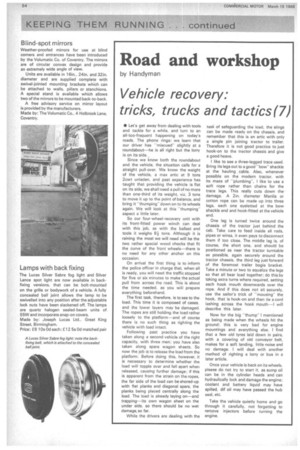Road and workshop
Page 56

If you've noticed an error in this article please click here to report it so we can fix it.
by Handyman
Vehicle recovery: tricks, trucks and tactics (7)
• Let's get away from dealing with tools and tackle for a while, and turn to an all-too-frequent happening on today's roads. The phone rings: we learn that our driver has -miscued" slightly at a roundabout—he is all right but the lorry is on its side..
Since we know both the roundabout and the vehicle, the situation calls for a straight pull-over. We know the weight of the vehicle, a max artic at 9 tons 2cwt unladen, and past experience has taught that providing the vehicle is flat on its side, we shall need a pull of no more than one-third of its weight, viz, 3 tons to move it up to the point of balance, and bring it -thumping" down on to its wheels again. We will look at this "thumping" aspect a little later.
So our four-wheel-recovery unit with its front-fitted power winch can deal with this job, as with the ballast and tools it weighs 8+ tons. Although it is raining the most we will need will be the two rather special wood chocks that fit the curve of the front wheels—there is no need for any other anchor on this occasion.
On arrival the first thing is to inform the police officer in charge that, when all is ready, you will need the traffic stopped for five or six minutes to make the actual pull from across the road. This is about the time needed, as you will prepare everything beforehand.
The first task, therefore, is to see to the load. This time it is composed of cases, and the lower layers may be damaged. The ropes are still holding the load rather loosely to the platform—and of course there is no such thing as righting the vehicle with load intact.
Following past practice you have taken along a second vehicle of the right capacity, with three men; you have also taken along spare wagon sheets. So now the job is to release the load from the platform. Before doing this, however, it is necessary to determine whether the load will topple over and fall apart when released, causing further damage; if this is apparent from the strain on the ropes, the far side of the load can be shored-up with flat planks and diagonal spars, the planks being placed centrally along the load. The load is already laying on—and trapping—its own wagon sheet on the under side, so there should be no wet damage, so far.
While the drivers are dealing with the task of safeguarding the load, the slings can be made ready on the chassis, and remember that this is an artic with only a single pin joining tractor to trailer. Therefore it is not good practice to just hook-on to the tractor chassis and give a good heave.
I like to see a three-legged trace used. Bring its legs out to a good "bow" shackle at the hauling , cable. Also, whenever possible on the modern tractor, with its maze of "plumbing", I like to use a soft rope rather than chains for the trace legs. This really cuts down the • damage. A 2in. diameter Manila or cotton rope can be made up into three legs, each one eyeletted at the bow shackle end and hook-fitted at the vehicle end.
One leg is turned twice around the chassis of the tractor just behind the cab. Take care to feed inside all rods, pipes or wires, it even pays to disconnect them if too close. The middle leg is. of course, the short one, and should be positioned as near the tractor turntable as possible. again securely around the tractor chassis, the third leg just forward of the foremost trailer bogie bracket. Take a minute or two to equalize the legs so that all bear load together; do this by taking extra turns where required, setting each hook mouth downwards over the rope. And if this does not sit securely, use the sailor's trick of "mousing" the hook, that is hook-on and then tie a cord lashing across the hook mouth—1 will describe this later.
Now for the big "thump" I mentioned as being made when the wheels hit the ground: this is very bad for engine mountings and everything else. I find that a few old tyres laid down in pairs, with a covering of old conveyor belt, makes for a soft landing, little noise and no damage. I will deal with another method of righting a lorry or bus in a later article.
Once your vehicle is back on its wheels, please do not try to start it, as sump oil can be in the cylinder heads and can hydraulically lock and damage the engine; coolant and battery liquid may have spilled, dif oil may have passed the hub seal, etc.
Take the vehicle quietly home and go through it carefully, not forgetting to remove injectors before turning the engine.




































































































































